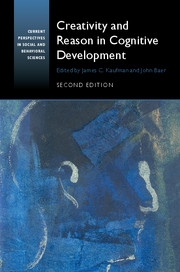Book contents
- Frontmatter
- Dedication
- Contents
- List of Contributors
- Acknowledgments
- 1 Creativity, Reason and Cognitive Development: Ten Years Later
- SECTION ONE CREATIVITY AND REASON IN CHILDHOOD AND THE SCHOOLS
- SECTION TWO CREATIVITY AND REASON IN COGNITION AND NEUROSCIENCE
- 8 The Role of Domain Knowledge in Creative Problem Solving
- 9 Processes, Strategies, and Knowledge in Creative Thought: Multiple Interacting Systems
- 10 Dynamic Processes within Associative Memory Stores: Piecing Together the Neural Basis of Creative Cognition
- 11 Creativity and Constraint: Friends, Not Foes
- 12 Creative Genius, Knowledge, and Reason: The Lives and Works of Eminent Creators
- 13 Attention, Cognitive Flexibility, and Creativity: Insights from the Brain
- SECTION THREE CREATIVITY AND REASON: INTERACTIONS AND RELATED CONSTRUCTS
- Author Index
- Subject Index
- References
9 - Processes, Strategies, and Knowledge in Creative Thought: Multiple Interacting Systems
from SECTION TWO - CREATIVITY AND REASON IN COGNITION AND NEUROSCIENCE
Published online by Cambridge University Press: 05 February 2016
- Frontmatter
- Dedication
- Contents
- List of Contributors
- Acknowledgments
- 1 Creativity, Reason and Cognitive Development: Ten Years Later
- SECTION ONE CREATIVITY AND REASON IN CHILDHOOD AND THE SCHOOLS
- SECTION TWO CREATIVITY AND REASON IN COGNITION AND NEUROSCIENCE
- 8 The Role of Domain Knowledge in Creative Problem Solving
- 9 Processes, Strategies, and Knowledge in Creative Thought: Multiple Interacting Systems
- 10 Dynamic Processes within Associative Memory Stores: Piecing Together the Neural Basis of Creative Cognition
- 11 Creativity and Constraint: Friends, Not Foes
- 12 Creative Genius, Knowledge, and Reason: The Lives and Works of Eminent Creators
- 13 Attention, Cognitive Flexibility, and Creativity: Insights from the Brain
- SECTION THREE CREATIVITY AND REASON: INTERACTIONS AND RELATED CONSTRUCTS
- Author Index
- Subject Index
- References
Summary
To a naïve person, creativity looks to be a lot of fun. You get to make up something new – something that might, in fact, change the world. However, the evidence we have gathered in recent years suggests that for those actually doing creative work, although it may be fun, it is also challenging. Most creative efforts fail (Huber, 1998). Creative people look to the past and, potentially, past failures (Antes & Mumford, 2009). Criticism, including self-criticism, appears critical to the success of creative efforts (Cropley, 2006; Gibson & Mumford, 2013). Creative people must worry about constraints on their solutions (Medeiros, Partlow, & Mumford, 2015) and the acceptance of their ideas by others (Rubenson & Runco, 1992).
Although many factors contribute to the difficulty of creative work, the fundamental nature of creative thought may also play an important role. Ultimately, creativity is a complex form of performance involving the production of solutions of high quality, originality, and elegance (Besemer & O'Quin, 1993; Christiaans, 2002) to problems that are complex, novel, ill defined, and poorly structured (Mumford & Gustafson, 1988, 2012). It is commonly held that the production of these problem solutions depends on three key cognitive capacities: (1) knowledge, (2) strategies used in working with this knowledge, and (3) the processes these strategies are being used to execute. Each of these components of creative thought has been studied in isolation. For example, Finke, Ward, and Smith (1992) have studied the impact of knowledge on creative problem solving. Mumford et al. (1997) have studied the impact of processing activities on creative problem-solving. The impact of both cross-process strategies, such as divergent thinking, and process-specific strategies, such as feature search and mapping, on creative problem solving has been examined in studies by Acar and Runco (2012) and Baughman and Mumford (1995).
This research has begun to provide us with a sounder and stronger understanding of the nature of creative thought. By the same token, the difficulty of creative work may lie not only in the difficulty of executing each of these discrete cognitive operations, but also in the nature of the interactions observed among these cognitive capacities as people seek to generate creative problem solutions. In this chapter, we examine some of the interactions likely to be observed among knowledge, processes, and strategies as people seek to generate creative problem solutions.
- Type
- Chapter
- Information
- Creativity and Reason in Cognitive Development , pp. 164 - 186Publisher: Cambridge University PressPrint publication year: 2016
References
- 2
- Cited by

